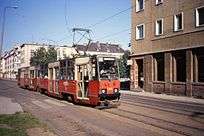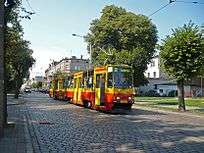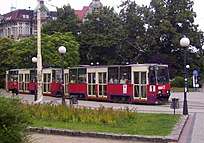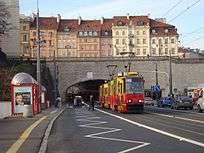Konstal 105Na
The Konstal 105Na are a class of Polish trams manufactured from 1979 to 1992 in workshops Konstal Chorzow, Poland. The narrow-gauge version is designed as 805Na. As of 2016 they are still the most common trams in Poland.
| Konstal 105Na | |
|---|---|
Konstal 105Na in Zabrze | |
| Manufacturer | |
| Constructed | 1979-1992 |
| Entered service | 1979 |
| Number built | 2134 |
| Capacity |
|
| Specifications | |
| Train length | 13,500 mm (44 ft 3 1⁄2 in) |
| Width | 2,400 mm (7 ft 10 1⁄2 in) |
| Height | 3,060 mm (10 ft 1⁄2 in) |
| Floor height | 890 mm (2 ft 11 in) |
| Doors | 4 |
| Maximum speed | 72 km/h (45 mph) |
| Weight | 17,000 kg (37,000 lb) |
| Power output | 4 x 41.5 kW (56 hp) |
| Bogies | 2 |
| Track gauge |
|
Construction
105Na is unidirectional motor tramcar, equipped with four doors.
It represents the development of the earlier tram Konstal 105N, the main changes being the location of the components of the electrical equipment which were transferred from under the steps to the back wall of the driver's cabin, the introduction of a separate cabin for the driver and the removal of the small windows under the front and side windscreens. The most important change was the introduction of motor grouping, which reduced the energy consumption by 12%. During initial acceleration, the four motors are connected in series, whilst at higher speeds, two groups of motors are connected in parallel.
While in service, the 105Na vehicles were the subject of various modifications and upgrades (including changes in the electrical system, new front plastic, change of the door opening mechanism, and even re-design, for Poznań, to the bidirectional Konstal 105NaDK). Almost all 105N cars in Poland have over time been modernised to the 105Na standard.
Other variants
The Konstal 105Na and 805Na trams provided the basis for the production of a large number of prototypes and variants:
- 105Nb - new doors and bogies, 15 units built in 1988-1993
- 105Nb/e - slightly modified electrical system, 6 units built in 1994
- 105Ne - slightly thicker walls, 18 units built in 1993
- 105Nf - modernized brakes and drivers console, 44 units built in 1994-1996
- 105Ng - three doors, static converter and modified breaks, 2 units built in 1993 additional units obtained by modernizing 105Na
- 105Nm - similar to 105Nf but with a static converter, 14 units built in 1996-1997
- 105Np - static converter, single unit built in 1994
- 105NT - thyristor based, 13 units built in 1985-1989, later converted to standard 105Na
- 105Nz - thyristor based and asynchronous motor, 2 units built in 1997
- 105N1k - similar to 105Ng but thyristor based, 3 units built in 1995
- 105N1k2 - similar to 105N1k but with electrical systems from a different supplier, 60 units built in 1995-2000
- 105N2k2000 - similar to 105N1k2 with a plastic front and rear, 36 units built in 2001
- 106N - thyristor based, 7 units built in 1977-1987, later converted to standard 105Na
- 106Na - thyristor based, 8 units built in 1991-1993
- 805Nb - meter-gauge version of the 105Nb
- 805NS - meter-gauge with new accelerator, 12 units built in 1984-1990
- 111N - with doors on both sides - two 111N cars connected back-to-back could work as a bidirectional tram, 6 units built in 1993
Production numbers
The number of standard-gauge version 105Na vehicles produced is 1443 while the number narrow-gauge version, the 805Na, is 691.
Operators
These trams are used in all Polish cities which operate a tram system and they are the largest group in the stock.
| Image | Operator | Number of 105Na in stock |
|---|---|---|
.jpg) |
MZK Bydgoszcz | 117 |
| MPK Częstochowa | 48 | |
 |
ZKM Elbląg | 21 |
| ZKM Gdańsk | 115 | |
 |
MZK Gorzów Wielkopolski | 18 |
 |
Tramwaje Śląskie | 299 |
 |
MZK Grudziądz | 20 |
| MPK Kraków | 37 | |
 |
MPK Łódź | 439 |
| MPK Poznań | 252 (35 Today)(Note: Being Replaced By Moderus Gamma Type) | |
 |
Trams in Szczecin | 2 + 12(after modernization) |
.jpg) |
MZK Toruń | 55 |
 |
Tramwaje Warszawskie | 561 |
.jpg) |
MPK Wrocław | 350 |
Gallery
- Konstal 105Na and variants
 Cockpit of 105Na
Cockpit of 105Na- Interior
 High floor is one of the main drawbacks of 105Na
High floor is one of the main drawbacks of 105Na 105NaDK - a bidirectional variant in Poznań
105NaDK - a bidirectional variant in Poznań Konstal 111N with doors on both sides
Konstal 111N with doors on both sides Konstal 105Nz
Konstal 105Nz.jpg) Konstal 105N2k2000 - one of the last produced
Konstal 105N2k2000 - one of the last produced- A modernised 105Na in Wrocław
.jpg) A modernised 105Na in Bytom
A modernised 105Na in Bytom.jpg) A modernised 105Na in Bytom - rear view
A modernised 105Na in Bytom - rear view.png) A modernised 105Na in Szczecin
A modernised 105Na in Szczecin- A modernised 105Na in Wrocław
- A modernised 105Na in Gdańsk
 105Na undergoing modernisation
105Na undergoing modernisation 105Na undergoing modernisation
105Na undergoing modernisation A Konstal 105Na in old...
A Konstal 105Na in old...- ...and new Warsaw livery
 105Na in Wrocław in 1989
105Na in Wrocław in 1989- 105Na in Wrocław, 2015
- 105Na in Poznań, 2015
- 105Na in Warsaw, 2015